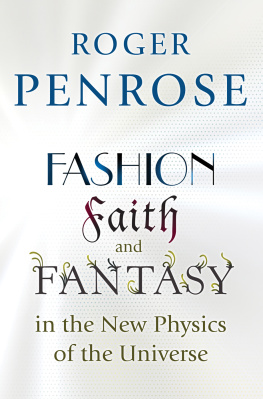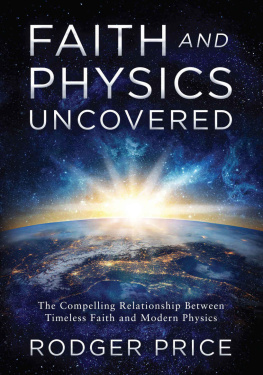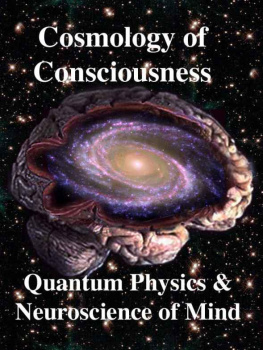Penrose - Fashion, Faith and Fantasy in the New Physics of the Universe
Here you can read online Penrose - Fashion, Faith and Fantasy in the New Physics of the Universe full text of the book (entire story) in english for free. Download pdf and epub, get meaning, cover and reviews about this ebook. City: Princenton etc, year: 2017;2016, publisher: Princeton University Press;Princenton University Press, genre: Children. Description of the work, (preface) as well as reviews are available. Best literature library LitArk.com created for fans of good reading and offers a wide selection of genres:
Romance novel
Science fiction
Adventure
Detective
Science
History
Home and family
Prose
Art
Politics
Computer
Non-fiction
Religion
Business
Children
Humor
Choose a favorite category and find really read worthwhile books. Enjoy immersion in the world of imagination, feel the emotions of the characters or learn something new for yourself, make an fascinating discovery.
Fashion, Faith and Fantasy in the New Physics of the Universe: summary, description and annotation
We offer to read an annotation, description, summary or preface (depends on what the author of the book "Fashion, Faith and Fantasy in the New Physics of the Universe" wrote himself). If you haven't found the necessary information about the book — write in the comments, we will try to find it.
Penrose: author's other books
Who wrote Fashion, Faith and Fantasy in the New Physics of the Universe? Find out the surname, the name of the author of the book and a list of all author's works by series.
Fashion, Faith and Fantasy in the New Physics of the Universe — read online for free the complete book (whole text) full work
Below is the text of the book, divided by pages. System saving the place of the last page read, allows you to conveniently read the book "Fashion, Faith and Fantasy in the New Physics of the Universe" online for free, without having to search again every time where you left off. Put a bookmark, and you can go to the page where you finished reading at any time.
Font size:
Interval:
Bookmark:

FASHION
FAITH
AND
FANTASY
in the New Physics of the Universe
ROGER
PENROSE
FASHION
FAITH
AND
FANTASY
in the New Physics of the Universe
PRINCETON UNIVERSITY PRESS
PRINCETON AND OXFORD
Copyright 2016 by Roger Penrose
Requests for permission to reproduce material from this work should be sent to Permissions, Princeton University Press
Published by Princeton University Press,
41 William Street, Princeton, New Jersey 08540
In the United Kingdom: Princeton University Press,
6 Oxford Street, Woodstock, Oxfordshire OX20 1TR
press.princeton.edu
Jacket design by Carmina Alvarez-Gaffin
All Rights Reserved
ISBN: 978-0-691-11979-3 (alk. paper)
Library of Congress Control Number: 2012931844
British Library Cataloguing-in-Publication Data is available
This book has been composed in Times
Typeset by T&T Productions Ltd, London
Printed on acid-free paper 
Printed in the United States of America
1 3 5 7 9 10 8 6 4 2
Contents

Acknowledgements

This books somewhat lengthy gestation has faded my memory of the sources of many contributions to its development. To such helpful but anonymous friends and colleagues I offer both my gratitude and apologies. There are of course others whom I clearly owe especial thanks, most particularly my long-time colleague Florence Tsou (Sheung Tsun) for her enormous help (also with her husband Chan Hong-Mo) regarding particle physics. My even longer-time colleague Ted (Ezra) Newman has provided continual insights and support over many years, and I benefited greatly from the knowledge and understandings of Abhay Ashtekar, Krzysztof Meissner, and Andrzej Trautman. Oxford colleagues Paul Tod, Andrew Hodges, Nick Woodhouse, Lionel Mason, and Keith Hannabuss have also greatly influenced my thinking. I have learned much of approaches to quantum gravity from Carlo Rovelli and Lee Smolin. Special thanks go to Shamit Kachru for his careful study of earlier drafts of this book, and although I doubt he will be happy with its expressed sentiments regarding string theory, his criticisms have been greatly helpful in reducing errors and misunderstandings on both sides.
For input of various kinds I am grateful to Fernando Alday, Nima Arkani-Hamed, Michael Atiyah, Harvey Brown, Robert Bryant, Marek Demianski, Mike Eastwood, George Ellis, Jrge Frauendiener, Ivette Fuentes, Pedro Ferreira, Vahe Gurzadyan, Lucien Hardy, Denny Hill, Lane Hughston, Claude LeBrun, Tristan Needham, Sara Jones Nelson, Pawel Nurowsski, James Peebles, Oliver Penrose, Simon Saunders, David Skinner, George Sparling, John Statchel, Paul Steinhardt, Lenny Susskind, Neil Turok, Gabriele Veneziano, Richard Ward, Edward Witten, and Anton Zeilinger.
Richard Lawrence and his daughter Jessica have been invaluable for providing numerous facts. For help in administrative ways, I thank Ruth Preston, Fiona Martin, Petrona Winton, Edyta Mielczarek, and Anne Pearsall. I am supremely grateful to Vickie Kearn of the Princeton University Press for her enormous patience, support, and encouragement, and to her colleagues Carmina Alvarez for her cover design and Karen Fortgang and Dimitri Karetnikov for their guidance with regard to diagrams, and to Jon Wainwright of T&T Productions Ltd for his careful editing. Finally, my wonderful wife Vanessa has kept me going, through difficult times, with her love, critical support, and technical expertise often magically rescuing me from seemingly hopeless entanglements with my computer. Huge thanks to her and also to our teenage son, Max, whose technical know-how and loving support have been invaluable.
ILLUSTRATION CREDITS
The author gratefully acknowledges the copyright holders of the following figures:
: After Rovelli [2004].
): From Cosmic Inflation by Andreas Albrecht, in Structure Formation in the Universe (ed. R. Crittenden and N. Turok). Used with permission of Springer Science and Business Media.
.
): From Eternal Inflation, Past and Future by Anthony Aguirre, in Beyond the Big Bang: Competing Scenarios for an Eternal Universe (The Frontiers Collection) (ed. Rudy Vaas). Used with permission of Springer Science and Business Media.
: Copyright of ESA and the Planck Collaboration
All other figures (excepting the computer curves in figures ) were drawn by the author.
Preface

ARE FASHION, FAITH, OR FANTASY RELEVANT TO FUNDAMENTAL SCIENCE?
This book has been developed from an account of three lectures I gave at Princeton University in October 2003 at the invitation of Princeton University Press. The title I had proposed to the Press for these lectures Fashion, Faith, and Fantasy in the New Physics of the Universe and which remains as the title of this book may well have been a somewhat rash suggestion on my part. Yet it genuinely expressed a certain unease I felt about some of the trends that were part of the thinking of the time concerning the physical laws governing the universe in which we live. Well over a decade has passed since then, but the topics, and much of what I had to say about them, appear to be, for the most part, at least as relevant today as they were then. I gave those talks with some apprehension, I might add, as I was trying to express some points of view that I worried might resonate not too favourably with many of the resident distinguished experts.
Each of the eponymous words fashion, faith, and fantasy suggests a quality that would seem to be very much at odds with the procedures normally considered appropriate when applied to a search for the deep principles that underlie the behaviour of our universe at its most basic levels. Indeed, ideally, it would be very reasonable to assert that such influences as fashion, or faith, or fantasy ought to be totally absent from the attitude of mind of those seriously dedicated to searching for the foundational underpinnings of our universe. Nature herself, after all, surely has no serious interest in the ephemeral whims of human fashion. Nor should science be thought of as a faith, the dogmas of science being under continual scrutiny and subject to the rigours of experimental examination, to be abandoned the moment that a convincing conflict arises with what we find to be the actuality of nature. And fantasy is surely the province of certain areas of fiction and entertainment, where it is not deemed essential that significant regard be paid to the requirements of consistency with observation, or to strict logic, or even to good common sense. Indeed, if a proposed scientific theory can be revealed as being too much influenced by the enslavement of fashion, by the unquestioning following of an experimentally unsupported faith, or by the romantic temptations of fantasy, then it is our duty to point out such influences, and to steer away any who might, perhaps unwittingly, be subject to influences of this kind.
Nevertheless, I have no desire to be entirely negative with regard to these qualities. For it can be argued that there is something of distinctly positive value in each of these eponymous terms. A fashionable theory, after all, is unlikely to have such a status for purely sociological reasons. There must indeed be many positive qualities to hold multitudes of researchers to a highly fashionable area of study, and it is unlikely to be the mere desire to be part of a crowd that keeps such researchers so fascinated by what is likely to be an extremely difficult field of study this very difficulty often having roots in the highly competitive nature of fashionable pursuits.
Next pageFont size:
Interval:
Bookmark:
Similar books «Fashion, Faith and Fantasy in the New Physics of the Universe»
Look at similar books to Fashion, Faith and Fantasy in the New Physics of the Universe. We have selected literature similar in name and meaning in the hope of providing readers with more options to find new, interesting, not yet read works.
Discussion, reviews of the book Fashion, Faith and Fantasy in the New Physics of the Universe and just readers' own opinions. Leave your comments, write what you think about the work, its meaning or the main characters. Specify what exactly you liked and what you didn't like, and why you think so.






